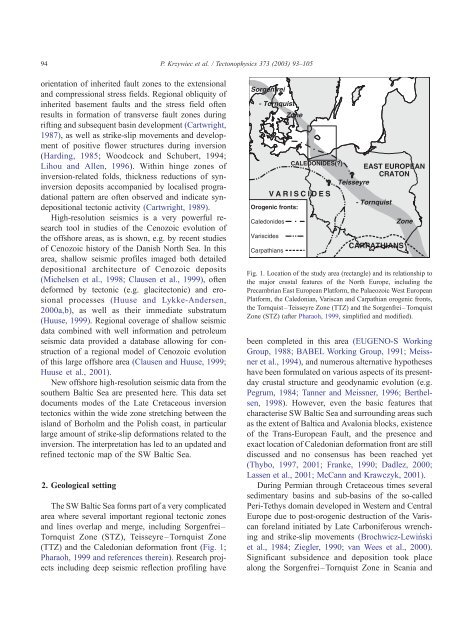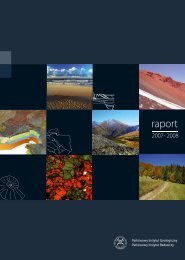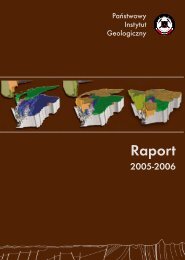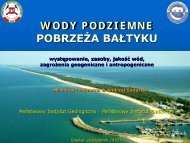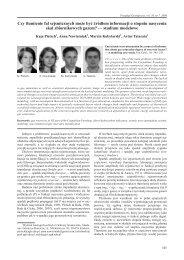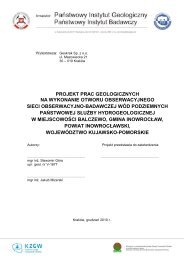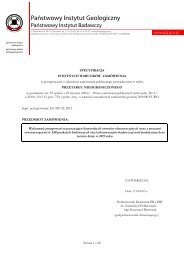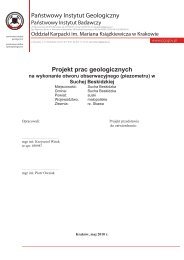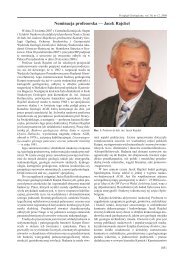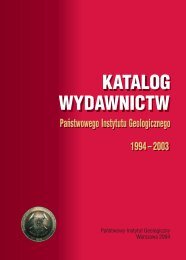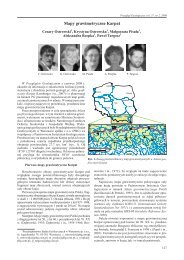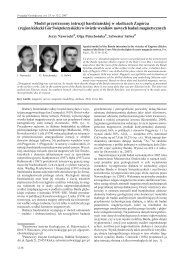Strike-slip tectonics within the SW Baltic Sea and its relationship to ...
Strike-slip tectonics within the SW Baltic Sea and its relationship to ...
Strike-slip tectonics within the SW Baltic Sea and its relationship to ...
You also want an ePaper? Increase the reach of your titles
YUMPU automatically turns print PDFs into web optimized ePapers that Google loves.
94<br />
orientation of inherited fault zones <strong>to</strong> <strong>the</strong> extensional<br />
<strong>and</strong> compressional stress fields. Regional obliquity of<br />
inherited basement faults <strong>and</strong> <strong>the</strong> stress field often<br />
results in formation of transverse fault zones during<br />
rifting <strong>and</strong> subsequent basin development (Cartwright,<br />
1987), as well as strike-<strong>slip</strong> movements <strong>and</strong> development<br />
of positive flower structures during inversion<br />
(Harding, 1985; Woodcock <strong>and</strong> Schubert, 1994;<br />
Lihou <strong>and</strong> Allen, 1996). Within hinge zones of<br />
inversion-related folds, thickness reductions of syninversion<br />
depos<strong>its</strong> accompanied by localised progradational<br />
pattern are often observed <strong>and</strong> indicate syndepositional<br />
tec<strong>to</strong>nic activity (Cartwright, 1989).<br />
High-resolution seismics is a very powerful research<br />
<strong>to</strong>ol in studies of <strong>the</strong> Cenozoic evolution of<br />
<strong>the</strong> offshore areas, as is shown, e.g. by recent studies<br />
of Cenozoic his<strong>to</strong>ry of <strong>the</strong> Danish North <strong>Sea</strong>. In this<br />
area, shallow seismic profiles imaged both detailed<br />
depositional architecture of Cenozoic depos<strong>its</strong><br />
(Michelsen et al., 1998; Clausen et al., 1999), often<br />
deformed by tec<strong>to</strong>nic (e.g. glacitec<strong>to</strong>nic) <strong>and</strong> erosional<br />
processes (Huuse <strong>and</strong> Lykke-Andersen,<br />
2000a,b), as well as <strong>the</strong>ir immediate substratum<br />
(Huuse, 1999). Regional coverage of shallow seismic<br />
data combined with well information <strong>and</strong> petroleum<br />
seismic data provided a database allowing for construction<br />
of a regional model of Cenozoic evolution<br />
of this large offshore area (Clausen <strong>and</strong> Huuse, 1999;<br />
Huuse et al., 2001).<br />
New offshore high-resolution seismic data from <strong>the</strong><br />
sou<strong>the</strong>rn <strong>Baltic</strong> <strong>Sea</strong> are presented here. This data set<br />
documents modes of <strong>the</strong> Late Cretaceous inversion<br />
<strong>tec<strong>to</strong>nics</strong> <strong>within</strong> <strong>the</strong> wide zone stretching between <strong>the</strong><br />
isl<strong>and</strong> of Borholm <strong>and</strong> <strong>the</strong> Polish coast, in particular<br />
large amount of strike-<strong>slip</strong> deformations related <strong>to</strong> <strong>the</strong><br />
inversion. The interpretation has led <strong>to</strong> an updated <strong>and</strong><br />
refined tec<strong>to</strong>nic map of <strong>the</strong> <strong>SW</strong> <strong>Baltic</strong> <strong>Sea</strong>.<br />
2. Geological setting<br />
The <strong>SW</strong> <strong>Baltic</strong> <strong>Sea</strong> forms part of a very complicated<br />
area where several important regional tec<strong>to</strong>nic zones<br />
<strong>and</strong> lines overlap <strong>and</strong> merge, including Sorgenfrei–<br />
Tornquist Zone (STZ), Teisseyre–Tornquist Zone<br />
(TTZ) <strong>and</strong> <strong>the</strong> Caledonian deformation front (Fig. 1;<br />
Pharaoh, 1999 <strong>and</strong> references <strong>the</strong>rein). Research projects<br />
including deep seismic reflection profiling have<br />
P. Krzywiec et al. / Tec<strong>to</strong>nophysics 373 (2003) 93–105<br />
Fig. 1. Location of <strong>the</strong> study area (rectangle) <strong>and</strong> <strong>its</strong> <strong>relationship</strong> <strong>to</strong><br />
<strong>the</strong> major crustal features of <strong>the</strong> North Europe, including <strong>the</strong><br />
Precambrian East European Platform, <strong>the</strong> Palaeozoic West European<br />
Platform, <strong>the</strong> Caledonian, Variscan <strong>and</strong> Carpathian orogenic fronts,<br />
<strong>the</strong> Tornquist–Teisseyre Zone (TTZ) <strong>and</strong> <strong>the</strong> Sorgenfrei–Tornquist<br />
Zone (STZ) (after Pharaoh, 1999, simplified <strong>and</strong> modified).<br />
been completed in this area (EUGENO-S Working<br />
Group, 1988; BABEL Working Group, 1991; Meissner<br />
et al., 1994), <strong>and</strong> numerous alternative hypo<strong>the</strong>ses<br />
have been formulated on various aspects of <strong>its</strong> presentday<br />
crustal structure <strong>and</strong> geodynamic evolution (e.g.<br />
Pegrum, 1984; Tanner <strong>and</strong> Meissner, 1996; Ber<strong>the</strong>lsen,<br />
1998). However, even <strong>the</strong> basic features that<br />
characterise <strong>SW</strong> <strong>Baltic</strong> <strong>Sea</strong> <strong>and</strong> surrounding areas such<br />
as <strong>the</strong> extent of <strong>Baltic</strong>a <strong>and</strong> Avalonia blocks, existence<br />
of <strong>the</strong> Trans-European Fault, <strong>and</strong> <strong>the</strong> presence <strong>and</strong><br />
exact location of Caledonian deformation front are still<br />
discussed <strong>and</strong> no consensus has been reached yet<br />
(Thybo, 1997, 2001; Franke, 1990; Dadlez, 2000;<br />
Lassen et al., 2001; McCann <strong>and</strong> Krawczyk, 2001).<br />
During Permian through Cretaceous times several<br />
sedimentary basins <strong>and</strong> sub-basins of <strong>the</strong> so-called<br />
Peri-Tethys domain developed in Western <strong>and</strong> Central<br />
Europe due <strong>to</strong> post-orogenic destruction of <strong>the</strong> Variscan<br />
forel<strong>and</strong> initiated by Late Carboniferous wrenching<br />
<strong>and</strong> strike-<strong>slip</strong> movements (Brochwicz-Lewiński<br />
et al., 1984; Ziegler, 1990; van Wees et al., 2000).<br />
Significant subsidence <strong>and</strong> deposition <strong>to</strong>ok place<br />
along <strong>the</strong> Sorgenfrei–Tornquist Zone in Scania <strong>and</strong>


